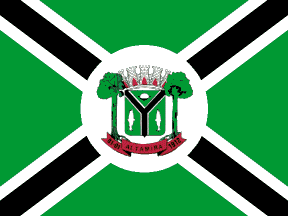 by Blas Delgado Ortiz
by Blas Delgado Ortiz
Last modified: 2002-07-13 by joe mcmillan
Keywords: brazil | pará | altamira | saltire | coat of arms | fishes: 2 | pall | rubber |
Links: FOTW homepage |
search |
disclaimer and copyright |
write us |
mirrors
The flag and coat of arms of Altamira were designed by the heraldist and
vexillologist Arcinóe Antônio Peixoto de Faria and approved by
law no. 051/78 of 2 December 1978. The flag measures 14 by 20 units and is green with a white-
bordered black saltire. The black stripes of the saltire are 1 unit wide with the
white border 1/2 unit wide. On the center is a white circle 8 units in diameter
[source erroneously says "circumference"] with the municipal coat of arms on it.
The design symbolizes Altamira's status as the hub of the transportation routes from
Amaz˘nia throughout Brazil. In addition, the stripes are intended to indicate the
force of municipal authority (the coat of arms) extending from the city where it has
its seat (the circle) throughout all parts of the municipal territory.
In addition, the colors are accorded the usual conventional symbolism: green
for agriculture, honor, civility, courtesy, joy, abundance, and hope;
white for peace, prosperity, religious purity; black for
austerity, prudence, wisdom, moderation, and character.
Source:
Altimira city website page on municipal symbols
Reported by Dov Gutterman, 4 March 2002
Summarized by Joseph McMillan, 15 March 2002
The same law describes the coat of arms as a Samnitic shield ensigned with a mural crown of eight towers argent lighted gules; the shield vert, a pall sable cotised argent, accompanied in chief by a ball of [raw] rubber and in the flanks by fishes palewise, all argent; as supporters on either side a chestnut three proper growing from a scroll gules, inscribed in silver with the place-name Altamira and the motto Capital da Transamaz˘nica, flanked by the date 01/01/1912.
According to the municipal website, the Samnitic shield, introduced
into Portugal by French influence, is used in Brazilian heraldry to evoke the
race of the Portuguese colonists. The mural crown with four visible towers
signifies a city of the second grade, the seat of a judicial circuit, or
comarca. The red illumination, by the heraldic significance of this
color, is consistent with the traits of the colonizing pioneers and the
leaders of the community. The color green is the symbol of
honor, civility, courtesy, joy, and abundance; it is also the
symbolic color of hope because it recalls the
verdant fields in the spring, giving hope of a plentiful harvest.
The black pall cotised silver connotes the Transamazônia Highway of which
Altamira is the principal hub. Black is the symbol of austerity, prudence, wisdom,
moderation, firmness, religiosity. The latex ball and the fishes
recall the principal economic activities of the municipality.
The chestnut trees show the natural richness of the
Amazonian forest, which made possible the occupation of the vast
territory and the formation of cities.
Reported by Dov Gutterman, 4 March 2002
Summarized by Joseph McMillan, corrected by Jorge Candeias, 15 March 2002